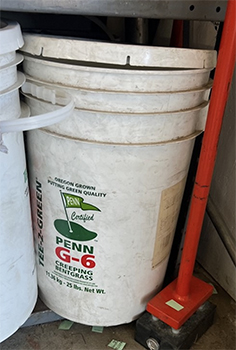Our customers often ask how long creeping bentgrass seed will last or hold its germ. Our advice is to buy what you need for a regular season and not worry if you end up with extra. That’s because bentgrass will last a long time if stored correctly, and when you come across that old bucket of seed stored or hidden away, you can always use it for divots or patchwork.
Germination rates vary considerably by plant and depend on how the seeds are stored. For example, fine fescue will be at 50% germ after only a year to two years. In contrast, in ideal conditions, Kentucky bluegrass, perennial ryegrass, and tall fescue seeds will have 50% germ after three years of storage. Creeping bentgrass has a longer shelf life than other seeds. If stored correctly, creeping bentgrass seeds germinate after five to six years or even more. One exception to all of the above is that if you coat the seed, the germ will fall very fast after the first year. So, only order what you plan to use or go with raw seed for best results.
Storage conditions greatly influence the viability of bentgrass. In general, seeds will maintain their viability longest if stored in cool, dry conditions, which are not the conditions we typically see in most barns and sheds.

Photo shows old bucket of bentgrass seed stored away losing germ.
The factors influencing seed viability include:
- Seed moisture content. An internal seed moisture level of 10 to 15 percent is ideal for most seeds, though this depends on the species. Seeds that lose moisture and fall below this level or absorb humidity to higher levels are likely to die. Typically, it is rare for seeds to fall below their optimum internal moisture levels, but they can easily absorb too much moisture when surrounding conditions are humid.
- Storage temperature. Ideal storage temperatures for most seeds are above freezing but under 70°F. Temperatures above 100°F can badly affect seed viability.
- Storage humidity. Moisture levels are subject to change for seeds stored in cloth sacks or open containers. In humid climates, they may absorb humidity.
For best results, keep all grass seeds stored in tightly sealed plastic buckets or containers so they cannot absorb moisture. You can extend seed viability by keeping it out of a hot barn or shed and storing it indoors in a cool area like an office or basement of the club. The cooler the storage temperature and the dryer the relative humidity, the longer your seeds will remain viable. Seeds stored in a sealed container in a refrigerator usually enjoy the best longevity. If this isn’t practical, seek out the coolest location at your facility. Seed stored with this kind of care may remain viable for as long as six years.
What do I do with my older seed or low-germ seed-
There is no harm in using some old grass seed for divot mix or reseeding, but you should expect a lower germination rate than you would enjoy with fresh turfgrass seed. We typically use too much seed in divot mix or patchwork, so low germ seed works great.
List of Germination Rates for Seeds
The following grass seed germination rates are within a range based on ideal conditions.
- Annual ryegrass: 5 to 10 days
- Bermuda grass: 10 to 30 days
- Buffalo grass: 14 to 30 days
- Creeping bentgrass: 5 to 10 days
(You may see germination within three days with newer cultivars)
- Hard Fescue: 7 to 14 days
- Kentucky bluegrass: 14 to 30 days
- Red fescue: 7 to 14 days
- Seashore paspalum: 7 to 14 days
- Tall fescue: 7 to 12 days
- Zoysia grass: 14 to 21 days




